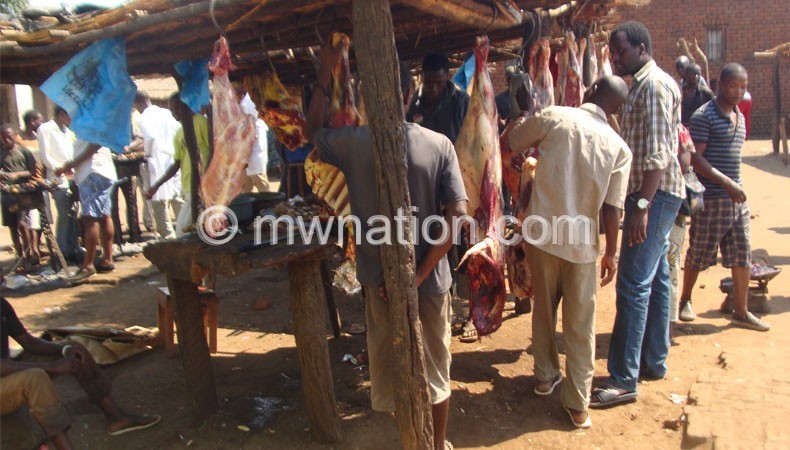Health risks on meat persist
Four years after raising an alarm that Malawians are silently eating diseased meat, the situation has worsened.
Now with only few designated slaughterhouses, where meat is thoroughly inspected, experts warn that most Malawians outside these areas are at risk of catching zoonotic diseases—diseases that are transferred from animals to humans.

In 2013, Nation on Sunday revealed how poor funding to Ministry of Agriculture’s Livestock Department and broken livestock infrastructure as well as inadequate trained personnel expose Malawians to these diseases, and the situation has not improved since.
But a 2016 Department of Livestock and Animal Health survey in Malawi revealed a TB prevalence rate of about 17 percent in cattle and goats in three abattoirs which were sampled.
The Meat and Meat Production Act only permits licensed abattoirs or designated slaughterhouses—where a veterinary expert is assigned to ensure that only disease-free animals are slaughtered.
Currently, Malawi has five designated slaughterhouses—two in Blantyre and three in Lilongwe—to cater for the cities.
The Malawi Veterinary Association estimates that the country has about 14 veterinary surgeons against the desired 60, which puts the ratio at 1 veterinary surgeon to over 10 000 animals to look after.
This, according to the association, has led to sporadic meat inspection, lack of animal disease surveillance and control.
The World Health Organisation (WHO) estimates that at least 60 percent of all human pathogens are zoonotic (come from animals) and that 75 percent of recently emerging infectious diseases are of animal origin.
Lilongwe University of Agriculture and Natural Resources (Luanar) animal scientist Jonathan Tanganyika said poor meat inspection is a cause for worry and government needs to do something about it sooner than later.
He said the free-for-all slaughter of animals must be put to a stop for public safety.
“Any animal slaughtered outside these designated areas must be questioned. In other areas, such as districts, there are selected points, especially near dip tanks where animals are slaughtered under a strict supervision of a veterinary surgeon or a para-veterinarian, but this is just on paper. The truth is that animals are slaughtered everywhere; hence posing a serious threat to public health,” said Tanganyika.
According to him, animals at an abattoir are first inspected—a process technically referred to as anti-moterm—and only fit ones are recommended for slaughter and the carcass is also tested (post-term) for any infection.
Tanganyika said the animal can be condemned in part, meaning only the affected area or the whole carcass.
Malawi Veterinary Association chairperson Dr. Joseph Nkhoma described the rate of disease detection at abattoirs as ‘frequent’ with partial condemnation of the carcass happening almost every day while total condemnation is rated at two to three times a week.
“This is why every animal must be certified fit by the veterinarian before slaughter and after slaughter to avoid transmission of these diseases. In fact, even animal slaughtered for home use, such as weddings and funerals, there is need to call a veterinary to do the inspection—it maybe idealistic, but that’s the standard,” he said.
Nkhoma said while TB remains a serious case, there were more diseases affecting animals.
He said: “Several diseases can be transmitted between animals and people through meat and livestock products. For example, in cattle there is TB which people can get through meat and milk. For goats, there is brucellosis, tuberculosis which causes undulant fever in people. For pigs, there is pork measles which is associated with epilepsy and other neurological diseases in people. In chicken, it is mainly salmonella infection and that’s a common cause of food poisoning.”
Chief environmental health officer Allone Ganizani said meat inspection must be intensified at all cost.
Ganizani also added that the Ministry of Health is currently reviewing the Public Health Act and policy to intensify food inspection and provide stiffer penalties to those who flout procedures such as selling uncertified meat.
Nation on Sunday randomly visited six butcheries in the capital city, but only one produced evidence (certificate/tag) from veterinary—meaning the meat was inspected.
This means the rest sold meat whose safety one could not be sure of.
Random interviews with some customers at meat selling points also showed their lack of information.
“I know for sure that what I am buying is good meat because I buy here every day without any problem. I don’t care whether it is inspected or not, but I trust this butchery,” said an Area 23 resident.
Consumer rights activist John Kapito said consumers were not to blame for their ignorance, but government, which has decided not to see the problem.
He indicated that he has visited many meat selling points which do not have their meat inspected.
A Luanar-based veterinary expert Professor Timothy Gondwe said people have been forced into a dire situation because the veterinary section has almost disappeared—there are no veterinary assistants anywhere near the people as was the case in the past.
In an interview, deputy director of Livestock Development in the Ministry of Agriculture, Patricia Kayuni, admitted that low funding affected their operations, adding that it remains their commitment to improving the situation.
She said the public had to join hands in ensuring that meat consumed is safe.
“People in different areas should take an initiative to ensure that the meat they consume is inspected because all markets are supposed to have an inspector— if it’s not a veterinary assistant then it must be a health surveillance assistant who does meat inspection,” said Kayuni.





